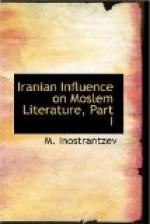Long after the Sasanian dynasty had fallen, and the rest of Persia had been subdued by the Arabs the Ispahabeds continued to strike their Pahlavi coinage and maintained the religion of Zoroaster in the mountains and forests of Tabaristan; and their struggles with the Arabs only ended about A.D. 838 by the capture and cruel execution of the gallant Maziyar, son of Qaren, son of Wanda-Hurmuz. For a vivid portrayal of the last days of this unfortunate scion of the lost empire of the Iranians the reader is referred to the vivid page of this English authority, who has reproduced the story of Zoroastrian aggressions in all its original spirit. And nothing less could be expected from a profound and sympathetic scholar to whom “All that concerns Maziyar is of supreme interest because it stands for the old Persian national and religious ideal”. (p. XII). Those who still hold in the teeth of historical fact that the empire and religion of Iran were overturned at one fell stroke by the ferocious Arabs may be referred to the alliance between the Ispahbed Shirvin and Windad-Hurmuz which brought it about that from one end to the other of a large track of country, “without their permission no one dared enter the highlands from the plains, and all the highlands were under their control. And when a Moslem died they would not suffer him to be buried in that country”. (p. 131). [italics mine, G.K.N.]
I will not further quote at length from this volume as it is in English but I cannot resist the temptation to call attention to page 146, which supplies a typical instance of conversion by persuasion and not persecution. Further note that the Khalif Mamun had a Zoroastrian astrologer whose Zoroastrian name the Khalif arabicised into Yahya ibn Mansur (p. 146). Though Maziyar outwardly embraced Islam he was probably in secret a Zoroastrian inasmuch as he continued to have a large Magian following and “conferred various offices and distinctions on Babak, Mazdak, and other Magians who ordered the Muhammadan mosque to be destroyed and all trace of Islam to be removed.” (p. 152-3). [Italics mine, G.K.N.] The Khalif Al-Muatasim was no less lenient in matters religious than some of the Khulfa i rashidin. In the year 854-55 he deputed one of his nobles to bid a Zoroastrian chieftain “break his Magian girdle and embrace Islam, which he did and thereupon received a robe of honour from the Khalif.” (p. 157). At page 157 we notice the extortionate practices of a Magian.
PARSI PRINCES DURING KHALIFAT.
“In the time of the Arabs we find an actual principality whose ruler bore the title of Masimogan or the elder of the Magians. To him also belonged the cities of Wima and Shalamba (Istakhri 209; Ibn Khurdadbeh 118; Ibn-al Faqih 284) as well as the territory of Khwar. [Magian princes during Khalifat (Tabari 12,656).]




